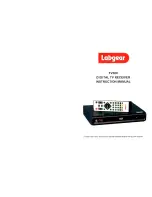
- 43 -
Glossary
Aspect Ratio
It is the ratio of the width of the screen to the height. The two relevant digital
TV formats are 16:9 (wide screen) or 4:3 (the traditional screen ratio). 16:9 is
ergonomically more suitable for the human eye.
Composite
Video
There are three elements of the video system: First - the "active video" which
means the picture to be displayed on the screen and its associated colors.
Second - the "sync" decides where to place each pixel on the screen. Third -
the "blanking" tells the display when to turn off the electron beam so no retrace
across the screen. These three elements combined together is called
"composite video" when connecting to a display through connectors.
DVB
Abbreviation for "Digital Video Broadcasting". An international organization
created in October 1993, whose primary objective is to achieve a common
framework for all technical platforms of digital broadcasting systems including
DVB-C (cable), DVB-S (satellite), DVB-T (terrestrial), DVB-MC (MMDS), DVB-
CS (SMATV)
.
EPG
Abbreviation for "Electronic Program Guide". It is software that enables
viewers to view current and upcoming programme details offered by digital TV
broadcasters.
Frequency
The property of a signal which is measured in cycles per second (=Hertz).
Letterbox
The picture with aspect ratio 16:9 in a 4:3 TV screen with blank lines on top
and bottom. It is the means to watch a wide screen TV program on a 4:3 TV
screen.
OSD
Abbreviation of "On Screen Display", used in digital set top box. OSD is
comprised of a main menu and many submenus with lots of options of
functions inside.
PAL
Stands for "Phase Alternating Line", the European video standard which has
the image format of 4 by 3, 625 horizontal lines, 50 Hz and a total 8 MHz of
video channel width.


































